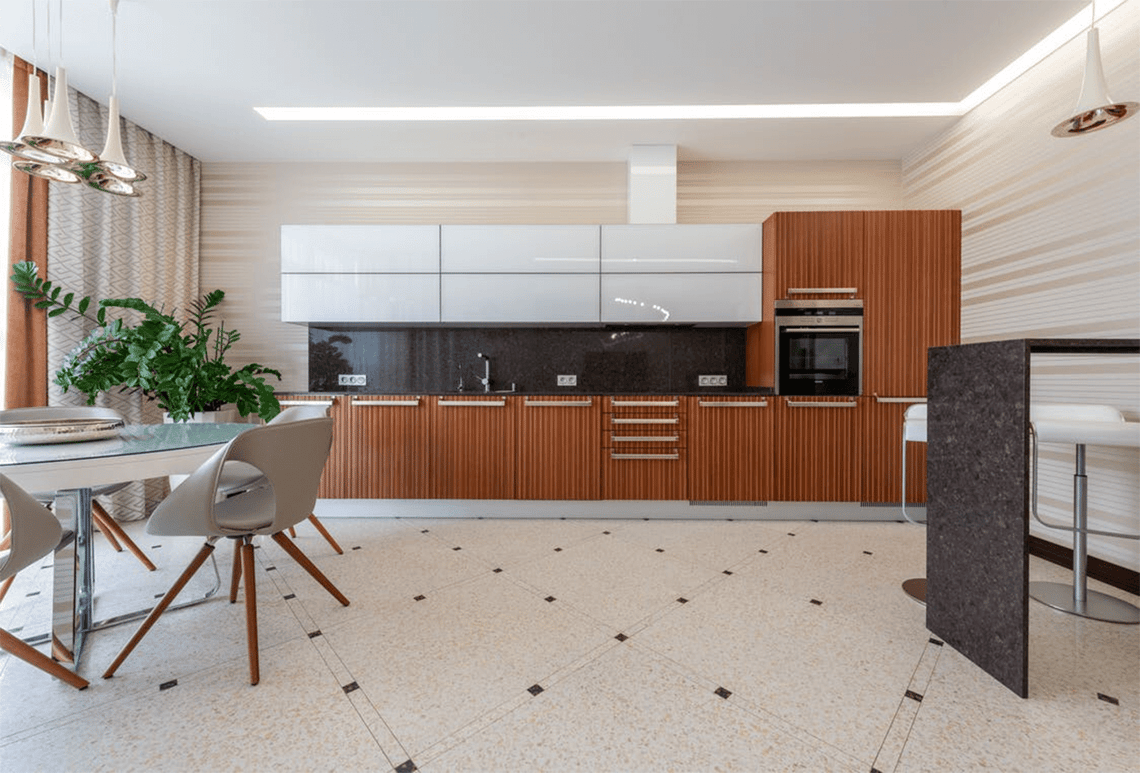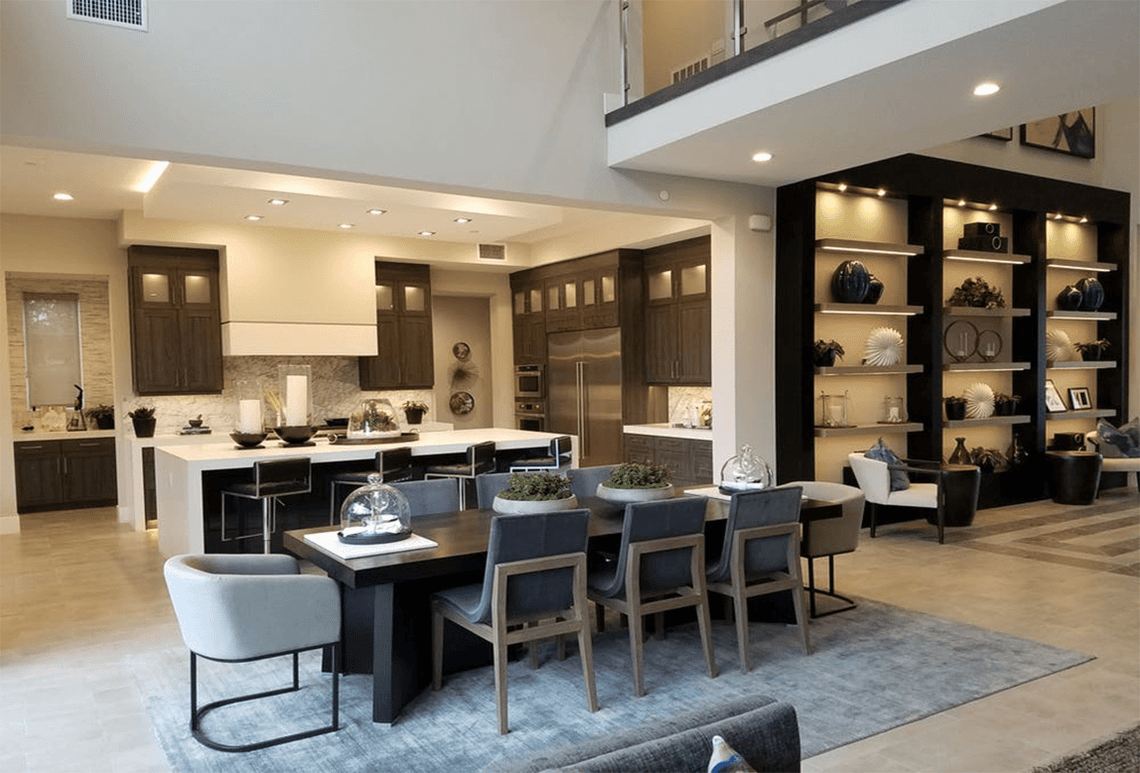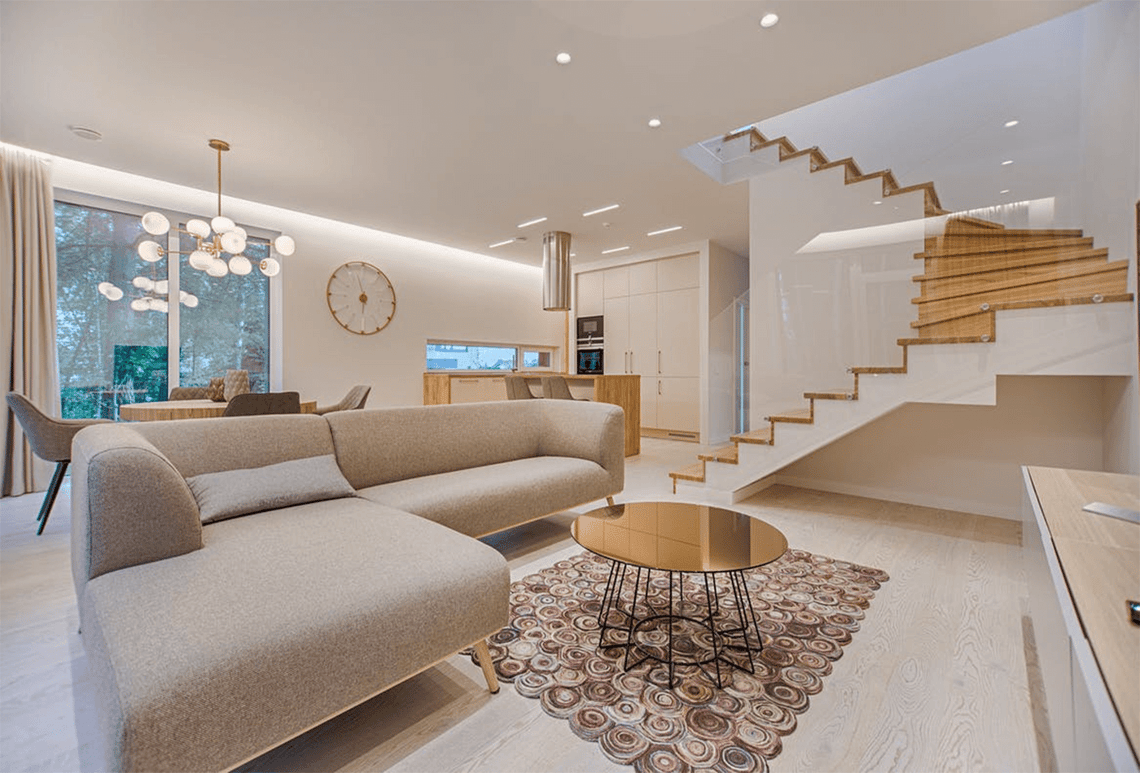Table Of Contents
Japandi-style kitchens are a relatively new trend but already have much-staying power. It's functional and stylish, with not just everything you need but also nothing you don't need.
Japandi (or Scandinese) kitchens combine Japanese and Scandinavian design elements. This trend infuses the best bits from both design styles to create the perfect balance of form and function.
Japandi Style Interior Design Living Room:

Materials Derived From Nature
Japandi interior design values sustainability or natural materials, with popular furniture and accessories made from wood, bamboo, hemp, stone, marble, and linen. While traditional Japanese design loves darker woods, the Scandinavian influence implies that Japandi prefers light woods such as oak. On the other hand, dark wood has a place in Japandi living rooms that can provide an exciting contrast if utilised sparingly.
Minimalist Style
Minimalism is popular among the Japanese and Scandinavian inspirations of this design trend, and it is an essential component of constructing any Japandi space. Avoid loud colours, intricate designs, and anything that produces clutter, and instead incorporate clean, sleek curves and lines that are attractive to the eye.
Stick To Japanese Colour Schemes
The Japandi aesthetic is readily recognised due to its neutral hue. Its predominant tones are white, cream, beige, grey, and pastel reds, with black and gold providing contrasting colours. There's no need to go for a wholly monochrome style, which can occasionally appear a little austere and uninviting. When designing a Japandi living room, choose furniture and accessories with warmer colours and include a few plants for greenery to create a welcoming feeling.
BLANCO BRAZIL GRANITE
£272.15 Bianco Brazil granite worktop is made from stone extracted from Brazil and features irregular grey veins that vary in thickness and give a cloudy pattern. Bianco Brazil granite features a white background that ranges in tone from slab to slab.… read more |
RUIVINA ESCURA MARBLE
£264.05 Ruivina Escura Marble is a grey hue. It is from Portugal. Ruivina Escura Marble is suited for both indoor and outdoor use. Natural factors such as snow, rain, wind, and pollution can all have an impact on the beauty and… read more |
BORGHINI QUARTZ
£363.09 Borghini is a style of Calacatta marble that is built with massive flow veins all through the slab. The veins' expressive movement is layered with warm tones and light colour changes. Borghini is a charming designer quartz. Because of the… read more |
What Are The Colours For Japandi Interior Design

The interiors of Japandi are soothing. This can be achieved by focusing on softer neutrals such as beige, grey, taupes, creams, and whites. The colours of natural materials will balance out this lightness. Black accents are frequently used to provide contrast and timelessness.
It's essential to note that Japandi design relies heavily on the concept of "wabi-sabi," which appreciates the beauty of imperfection and embraces natural elements. As such, the colour palette should be soothing and balanced, focusing on creating a serene and timeless environment. Introduce colours through textiles, artwork, and decor items to add interest and personality while keeping the overall scheme understated and harmonious.
Does Japandi Kitchen Do Well With Natural Stone Flooring:

A Japandi kitchen can go very well with natural stone flooring. Among various natural stone options, the one that best fits a Japandi kitchen is light-coloured marble flooring. Here's why:
Light-Coloured Marble Flooring

Minimalistic Aesthetic
Light-coloured marble, such as Carrara or Calacatta, aligns with the minimalist principles of Japandi design, emphasising simplicity and clean lines.
Timeless Elegance
Marble exudes timeless elegance, which is a crucial characteristic of Japandi interiors. Its soft veining and subtle patterns add a touch of sophistication to the space.
Connection To Nature
Marble is a natural stone, and its surface often resembles elements found in nature, like flowing water or tree veins. This resonates with the Japandi design philosophy of bringing the outdoors in.
Versatile Design
Light-coloured marble is versatile and can work well with various design elements, including wooden cabinetry, matte finishes, and natural fibres like bamboo or rattan, commonly found in Japandi interiors.
PREMIUM WHITE PORCELAIN
£457.15 Premium White Porcelain has a calming white base that features subtle bluish-grey veins. This porcelain is given a perfect finish that makes a perfect addition in both residential and commercial settings. It is a dream come true for kitchens, baths,… read more |
EMERALD GREEN QUARTZITE
£898.28 Emerald Green Quartzite has an attractive green base which is adorned with a lovely veined pattern. This stone can be used in both modern and classic style kitchens, to add a unique touch to your environment. Quartzite is offered by… read more |
How To Style Your Japandi Style With Work-tops.com

Styling your Japandi-inspired space with a stone tabletop from Work-tops involves a thoughtful blend of Japanese minimalism and Scandinavian simplicity. Begin by embracing the essence of minimalism, keeping the table surface clean and uncluttered. Choose a suitable stone, like light-coloured marble or soft-toned quartzite, to maintain a serene backdrop that complements the Japandi aesthetic.
-
Pair your stone tabletop with natural elements, such as wooden chairs or benches, with clean lines and a natural finish. To create a tranquil setting, keep the colour palette neutral and muted, featuring soft whites, warm greys, and earthy tones.
-
For tableware, opt for minimalist designs in ceramics or stoneware with muted colours, avoiding excessive patterns. Introduce natural textiles like linen or cotton table runners to add softness and texture.
-
Keep decor items minimal—a vase with fresh or dried flowers a tray with candles, or succulents can suffice. Functional accessories, like elegant cutlery and wooden or stone coasters, should be practical and visually pleasing.
-
Ensure your dining area has quality lighting, such as pendant lights or a modern chandelier, to enhance the ambience. Maintain balance and symmetry in your table setting for visual appeal.
-
In styling your Japandi space with a stone tabletop, remember that the goal is to achieve harmony between two design philosophies, creating an inviting and tranquil dining area where minimalism and natural elements shine.
You definitely check out our collections and contact us at info@work-tops.com
SNOWY IBIZA SILESTONE
£470.49 Snowy Ibiza Silestone is composed of 94% natural Quartz, making it an extremely durable and resilient stone. This is the only Quartz worktop with anti-bacterial protection, offering sanitary features not found elsewhere on the market. It's a good surface for… read more |
TAJ MAHAL SENSA
£709.74 Taj Mahal Sensa is appropriate for any kitchen style. Due to its rustic beauty, it is more suitable for traditional kitchen styles. This ivory granite worktop looks well with grey, black, white, beige, brown, and cream. The term Taj Mahal… read more |
KILKENNY SUPER LIMESTONE
£284.14 Kilkenny Super Limestone is a widely recognised and highly prized limestone originating in Ireland's County Kilkenny. It is often called Kilkenny Marble due to its appearance, but technically it is limestone. The light grey compacted crinoid limestone is known for… read more |
Frequently Asked Questions
-
How Do I Incorporate The Japandi Style Into My Home?
To incorporate the Japandi style, start by decluttering and simplifying your space. Use natural materials like wood and stone, choose a neutral colour palette, and embrace minimalist furniture with clean lines. Introduce elements of nature, such as plants and natural textiles, for a calming atmosphere.
-
What Are The Key Characteristics Of The Japanese Style?
Key characteristics of the Japandi style include:
-
Minimalism.
-
A neutral colour palette.
-
Natural materials.
-
Clean lines in furniture and decor.
-
A focus on balance and harmony.
-
An appreciation for craftsmanship and simplicity.
The style promotes a sense of tranquillity and mindfulness in the home.
-
What Types Of Materials Are Commonly Used In Japandi Design?
Natural materials are a hallmark of the Japanese style. Wood, bamboo, stone, and natural fibres like cotton and linen are commonly used. These materials emphasise the connection to nature and contribute to the style's warmth and simplicity.
P.s. The readers are informed that none of the content available on any of the pages of Work-tops.com should be taken as legal advice and that Work-tops will not be held accountable for your use of the information contained in or linked from these web pages.




